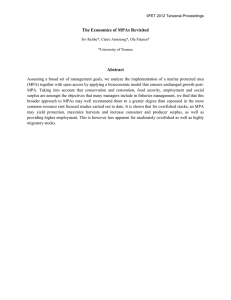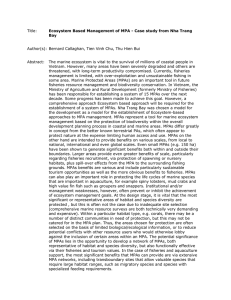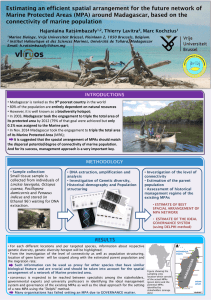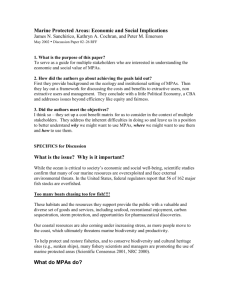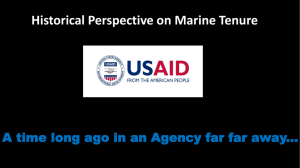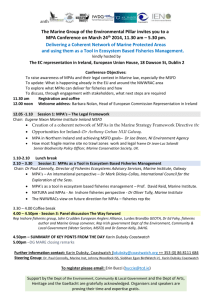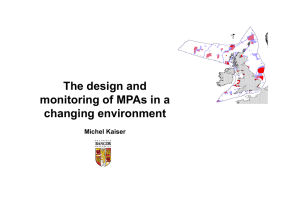Marine Protected Areas: Can They Revitalize Our Nation’s Fisheries?
advertisement
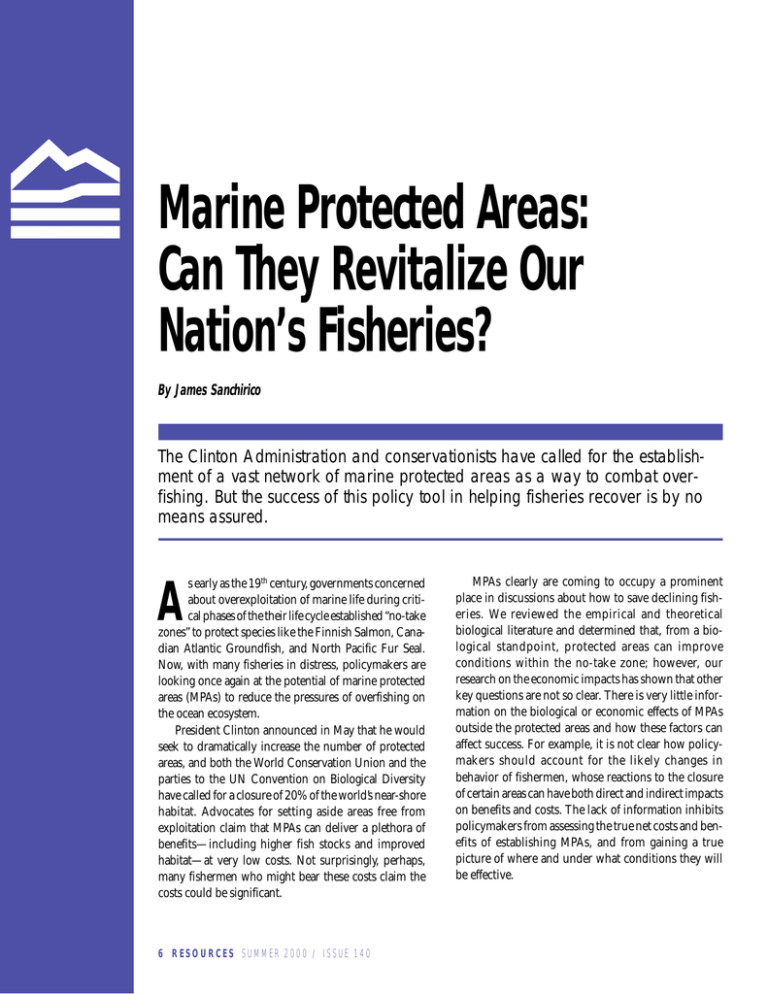
Marine Protected Areas: Can They Revitalize Our Nation’s Fisheries? By James Sanchirico The Clinton Administration and conservationists have called for the establishment of a vast network of marine protected areas as a way to combat overfishing. But the success of this policy tool in helping fisheries recover is by no means assured. A s early as the 19th century, governments concerned about overexploitation of marine life during critical phases of the their life cycle established “no-take zones” to protect species like the Finnish Salmon, Canadian Atlantic Groundfish, and North Pacific Fur Seal. Now, with many fisheries in distress, policymakers are looking once again at the potential of marine protected areas (MPAs) to reduce the pressures of overfishing on the ocean ecosystem. President Clinton announced in May that he would seek to dramatically increase the number of protected areas, and both the World Conservation Union and the parties to the UN Convention on Biological Diversity have called for a closure of 20% of the world’s near-shore habitat. Advocates for setting aside areas free from exploitation claim that MPAs can deliver a plethora of benefits—including higher fish stocks and improved habitat—at very low costs. Not surprisingly, perhaps, many fishermen who might bear these costs claim the costs could be significant. 6 RESOURCES SUMMER 2000 / ISSUE 140 MPAs clearly are coming to occupy a prominent place in discussions about how to save declining fisheries. We reviewed the empirical and theoretical biological literature and determined that, from a biological standpoint, protected areas can improve conditions within the no-take zone; however, our research on the economic impacts has shown that other key questions are not so clear. There is very little information on the biological or economic effects of MPAs outside the protected areas and how these factors can affect success. For example, it is not clear how policymakers should account for the likely changes in behavior of fishermen, whose reactions to the closure of certain areas can have both direct and indirect impacts on benefits and costs. The lack of information inhibits policymakers from assessing the true net costs and benefits of establishing MPAs, and from gaining a true picture of where and under what conditions they will be effective. MARINE PROTECTED AREAS Potential Benefits and Costs of MPAs Protected Areas Outside the Protected Area Potential Benefits Healthier fish stocks Community structure Improved habitat Hedge against stock collapse Biodiversity enhancement Potential Benefits Links Spillover effects Potential Costs Reduction in fishable waters Habitat conditions The boundaries of the two areas are drawn with dashed lines to symbolize the openness of the marine ecosystem. The link between the two areas is formally defined by the migration/dispersal patterns of fish stocks residing within and outside the protected areas along with the geographic or oceanographic characteristics of the marine environment. In general, fish migration patterns depend upon currents, temperatures, prevailing winds, and behavioral characteristics. The term “community structure” refers to the potential benefits in age/size structure of the fish stock and in trophic levels present in the protected area. Economic Assessment From an economic perspective, MPAs represent a public investment, and cost-benefit and cost-effectiveness analyses can be used to measure their impact. Economic analysis is complicated by several factors, however; for example, the benefits of MPAs— healthier fish stocks—will be realized at some future date, whereas the majority of the costs are incurred initially. Also, even though the goal of an MPA may be fishery enhancement, the benefits MPAs provide may be broader in scope and include habitat improvements or the enhancement of other uses, such as recreation. Fishermen perceive that they will most likely bear the majority of the costs of closing areas without any guarantees that they will be the recipients of the benefits. Thus, inherent in the policy debate is the potential transfer of resource rights from fishermen to others. Further muddying the waters (so to speak!) are the biological and economic uncertainties inherent in complex fishery systems and the calculation of nonconsumptive use benefits. Valuing the benefits from activities such as education, diving, photography, and tourism that might arise from closing certain areas to fishing requires data not typically collected by fishery managers. Consequently, it is difficult to fully quantify the benefits from MPAs, leaving fishery managers, industry, and conservation organizations to debate their existence and magnitude. Biological Benefits Empirical evidence backs the contention that no-take zones can often yield many biological benefits within the zone, including reductions in: the pressure placed on exploited stocks, stresses on ecosystems, the amount of bycatch (inadvertent taking of another species), and destruction of the benthic environment (the ocean floor) from harmful fishing practices. MPAs also have been shown to increase the age and size of the fish stock, spur higher stock levels, and foster improvements in habitat. Although SUMMER 2000 / ISSUE 140 RESOURCES 7 RESOURCES FOR THE FUTURE Fishing in some of the areas where fishermen choose to go in the overall direction of positive changes is clear, it is difficult to the face of closures could be more biologically detrimental than predict the magnitude and forms of the changes in advance. in the areas declared off-limits. Some advocates also claim that MPAs will provide “spillover” effects, spurring ecological improvements in adjaEconomic Impact cent nonprotected areas. For this to happen, however, there must be a biological link between the closed and open areas The net economic impact of no-take zones depends on whether (see figure on previous page). If this link does not exist, closthe values of broad ecosystem benefits exceed the potential ing off areas will only have local ecological impacts. If the link costs they may impose on fishermen and other current users. is too strong, however, as in the The direct costs of MPAs stem case of a pelagic (open sea) from the reduction in fishable What is an MPA? species with high mobility, waters after an MPA is sited, then the impact of a protected and include lost harvest opporAccording to the World Conservation Union area fixed in space might be tunities and increases in (IUCN), a marine protected area (MPA) is “any area biologically insignificant, harvesting costs. However, the of intertidal or subtidal terrain, together with its overlybecause the fish stock will favorable spillover effects from ing waters and associated flora, fauna, historical and likely spend most of the time an MPA can outweigh the costs, cultural features, which has been preserved by legislation resulting in positive net ecooutside the boundaries of the or other effective means to protect all or part of the enclosed nomic benefits. And, because MPA. In general, the magnienvironment.” While the IUCN establishes a forwardit is still unclear what the biotude and nature of the spillover looking agenda for setting aside areas, the current logical effect in the noneffects to the nonprotected sanctuary system within the United States is based on protected area will be, it is areas depends on the biologimore traditional goals and the use of set-aside areas. In cal openness of the system, unknown what the net effect the United States, the National Marine Sanctuary Act will be. which is defined by the disdefines a sanctuary as an area of the marine environment Again, the answer depends persal of the fish stocks. As a of special national significance due to its resource or in large part upon the biological result, understanding these human-use values, designated as such to ensure its confundamental processes is critiand economic linkages between servation and management. In general, MPAs by definition cal to determining the net the refuge and fishery areas. Sitconsist of well-delineated areas that either by decree or biological benefits of MPAs. ing an MPA in an open system legislative action prohibit certain activities. The level of proMany proponents of MPAs provides the greatest opportutection (no commercial fishing zones versus certain gear claim that they will provide nity for spillover effects to restrictions), the goals (e.g., fishery enhancement, biodibroad ecosystem benefits outweigh economic losses from versity, and habitat restoration) and the size, shape, and including improvements in the reduction in fishable waters. location are all key talking points in the debate deterhabitat and restoration of However, if the protected area is mining if protected areas are worthwhile. healthy marine life communitoo “porous,” then the biologities throughout the ocean cal improvements within the ecosystem. These benefits are most likely to be felt within the area will not be fully realized, because the species will spend protected area, but again outside of this area the effects are very little time within the boundary of the MPA. unclear. Closing off an area will prompt fishermen to go elseIn fact, our research shows that the circumstances most likely where, putting new pressures on the remaining open grounds. to generate broad biological benefits at the lowest costs to fishThis shift could mitigate any broad ecosystem benefits, because ermen are those in which the protected area is moderately porous it could increase the intensity level of activities in the remainand the system has been dramatically overexploited. In these ing nonprotected areas, further degrading habitat, and potentially circumstances, the fishermen have the least to lose from the clocreating a marine environment dotted with islands of producsure and the biological system has the most to gain through tive habitat surrounded by vast expanses of depleted habitat. spillover effects. Our research results show more generally the 8 RESOURCES SUMMER 2000 / ISSUE 140 MARINE PROTECTED AREAS importance of considering both economic and biological factors in siting reserves. The fact is that reserve siting will not be decided on purely biological criteria. Instead, decisions will be made in a political arena, reflecting biological and economic tradeoffs, and influenced by perceptions about costs and benefits by various stakeholder groups. While the biological link between the MPA and the larger fishery (remaining open areas) is important to determining the net effects, the response by the fishing industry is just as significant. If the industry responds to the no-take zones by fishing more intensely in the areas that are still open, these regions could be turned into barren swaths of marine environment, weakening the case that MPAs had a positive effect on the entire marine habitat. Gaining a better understanding of how the fishing industry will respond is critical to predicting the expected net effects from MPAs. Policy Considerations Many advocates claim that MPAs provide a hedge against fishery management failures and, therefore, MPAs make sense as a precautionary approach. In fact, MPAs can provide a degree of spatial protection to a fraction of total fish stocks; the degree of the protection depends on the openness of the system. If poor stock assessments and/or inadequate political will to set total allowable catches at biological and economic sustainable levels are the leading causes of fishery collapses, then MPAs might be a good hedge against management failures. However, the fact that most marine environments are open and susceptible to broad oceanographic shocks, such as those caused by El Niño, may reduce the degree of protection pro- vided the stock or the quality of the hedge. In addition, if there is little or no enforcement and monitoring of the protected area, then the expected ecological benefits will most likely go unrealized. While MPAs might provide short-term protection in certain settings, the combination of the openness of the marine environment, stock mobility, and the response by the fishermen appear to increase the long-run uncertainty associated with using MPAs. What role should protected areas play in fishery regulation of the new century? MPAs seem particularly important as an instrument to ensure that special treasures, like unique habitat and biodiversity, are preserved for posterity. MPAs also have the potential to provide a margin of safety and perhaps even enhance the productivity of some fisheries. But their usefulness as a fisheries management tool to mitigate the ills of overfishing is less clear. Fisheries are common property resources, and individual users of the resource do not face the proper incentives to conserve the stock. While MPAs might provide a safe buffer under certain circumstances, they are still addressing a symptom and not the fundamental cause of overfishing and waste in fisheries. Until institutions are designed that change the incentives fishermen experience, policymakers will continue to face the overcapacity problems that have given rise to the recent momentum for increasing the scale and scope of MPAs. James Sanchirico is a fellow in RFF’s Quality of the Environment Division. This article is based on ongoing research being conducted with James E. Wilen, Ph.D., Department of Agricultural and Resource Economics, University of California, Davis. More information on RFF’s research efforts in this area can be found on our Web site at www.rff.org/ nat_resources/fisheries.htm. SUMMER 2000 / ISSUE 140 RESOURCES 9
